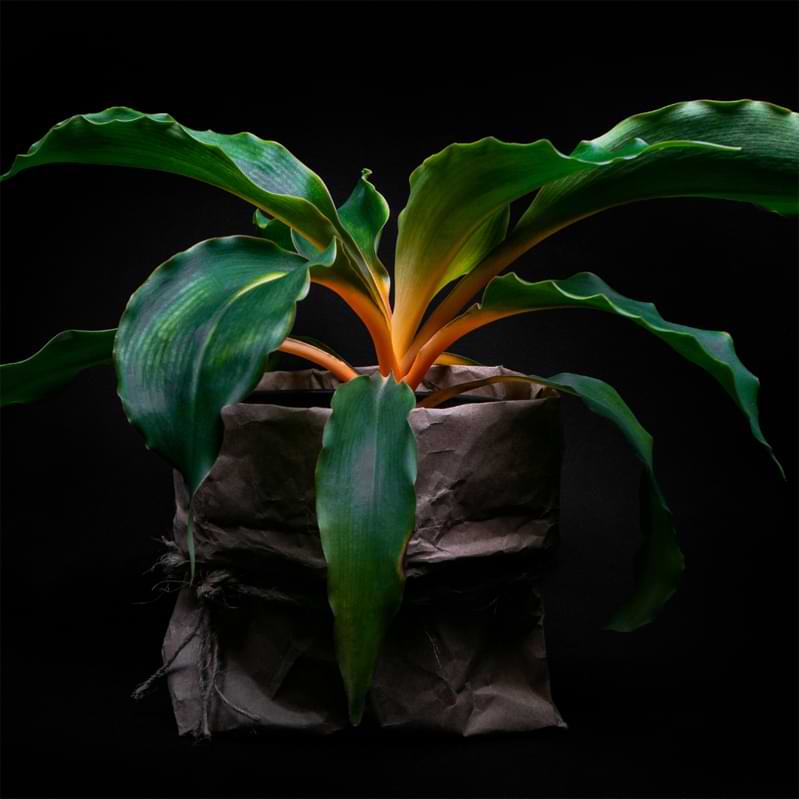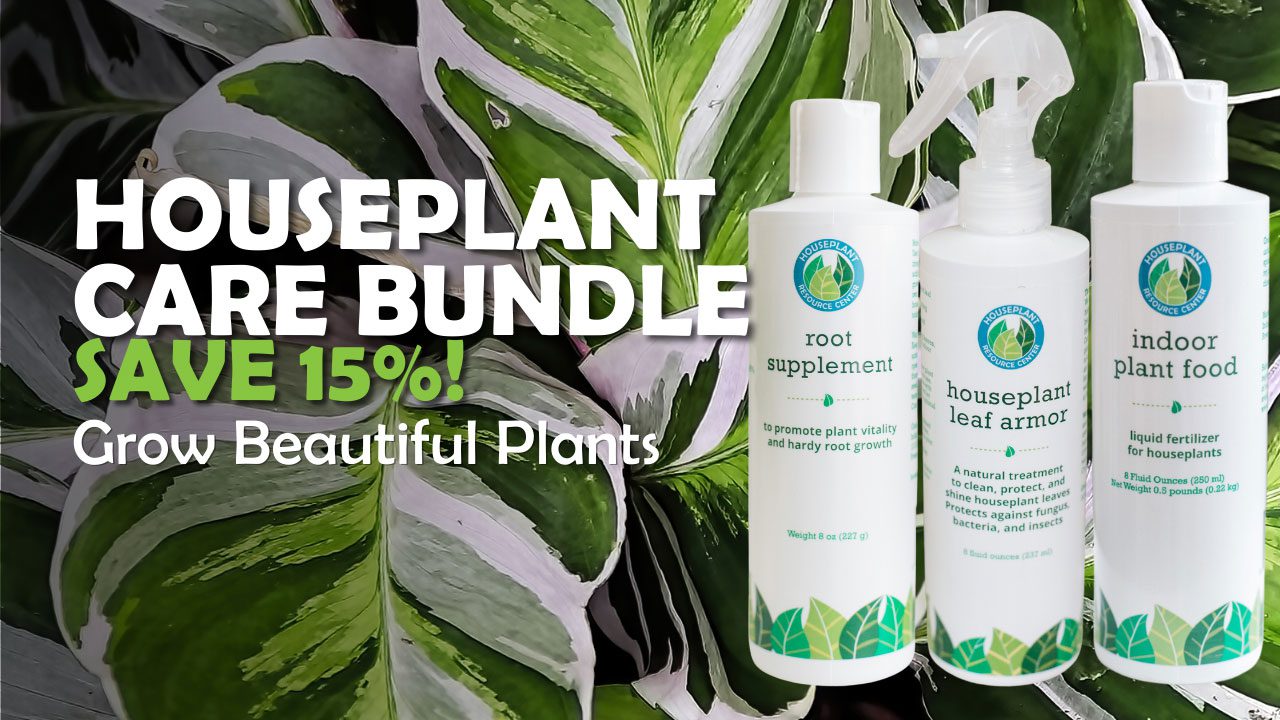Exotic Angel® is not a type of plant, but is actually a brand name trademarked by Hermann Engelmann Greenhouses, Inc. You’ll find these plants everywhere, from online shops to local garden centers to big home improvement chains like Home Depot and Lowe’s.
All Exotic Angel® plants are grown in Exotic Angel® greenhouses, which are now owned by Costa Farms, and are known for their quality. Exotic Angel® takes great care to ship only healthy specimens, and plants more cuttings together than many other brands, which leads to fuller, lusher plants!
This brand includes around 400 different plant varieties, many of which you might already be familiar with, like ficus, ferns, and pothos. You’ll also see some more exotic brands like laceleaf, dumb cane, dragon plant, purple passion plant, etc.
Different varieties have different needs, but we’ll go over basic care guidelines that will give you a great baseline for just about any Exotic Angel® plant, include specific tips for 10 different varieties, and how to tell if your Exotic Angel® isn’t happy with its care!
Table of Contents
How To Care For Exotic Angel® Plants
Since there are so many varieties of these plants, their needs will vary.
However, most tropical plants have similar needs, so these care guidelines are a great place to start if you aren’t sure how to care for your Exotic Angel® plant, or if you purchase a plant without a care tag inserted in the soil. (All Exotic Angel® plants come with a tag that names the variety and outlines care instructions, but these can sometimes get lost!)
Light
As a rule, most tropical plant varieties do best in bright, indirect sunlight. This means that they are near a bright window, but never directly in the sun’s rays.
An east-facing window is usually a good bet, but a south- or west-facing window can also work if you don’t place the plant right smack in the middle where the hot afternoon sun will shine right on it.
A north-facing window may not be bright enough for some light-loving varieties like a ficus, but this might be a good place for a low-light plant like a peperomia, pothos, or a nerve plant.
If you aren’t sure of your Exotic Angel® plant variety, start with bright, indirect light and move to a lower-light room if you notice the colors appearing washed-out or faded.
Watering
Water needs also vary from variety to variety, but most Exotic Angel® plants require evenly moist, but not oversaturated soil. This means that you water when the top few inches of the soil are dry.
Some more drought-tolerant varieties like pothos, dracaenas, or succulents may need less water. For these varieties, wait until the top half of the soil dries out.
For water-loving varieties like ferns, water when the top inch is dry.
If you aren’t sure about your variety, start by watering when the top 3 inches are dry. Are the leaves droopy or are they getting crispy around the edges, water more. Yellowing or stems getting soft indicate it is time to water less often.
One thing you definitely want to do for any Exotic Angel® plant is use a pot with drainage holes so the plant’s roots are never sitting in water.
Humidity
Most tropical Exotic Angel® plants appreciate a bit of humidity. (40%-50% humidity is usually best.) Try setting up a humidifier nearby, placing the plant on a pebble or humidity tray, or grouping plants together to increase humidity.
Other varieties like dragon trees may not need much humidity. Keep an eye on your plant’s leaves and notice if they start getting dry spots even though your watering routine is spot-on.
Potting Mix
Your potting mix for any Exotic Angel® plant should be fast-draining, well-aerated, and retain some moisture, but not too much.
Cactus mix with extra perlite mixed in is a safe choice for most varieties. For drought-tolerant Exotic Angel® plants, don’t be afraid to mix in a little extra perlite or bark chips to increase the drainage even more. With water-loving varieties like ferns, indoor potting mix with a little extra peat works well.
For all varieties of vining plants and aroids like pothos, philodendron, and peace lilies, we recommend our Monstera Potting Mix because it’s the perfect balance of drainage and moisture retention for aroids, and it’s highly nutritious too!
For ficuses and other trees, we recommend our Fiddle Leaf Fig Potting Mix for a lot of the same reasons. (In fact, this is a pretty good all-purpose potting soil because it stays well-aerated, drains fast, and stays just damp enough to keep most plants hydrated between waterings!)
Feeding
A plant can use up all the available nutrients in its pot within a few months, so it’s important to fertilize your Exotic Angel® plant regularly!
Our favorite all-purpose liquid fertilizer is Indoor Plant Food because it’s simple to use, you don’t have to remember a fertilizing schedule, and it works for just about any type of Exotic Angel® plant. (Just don’t use it on succulents. They have different nutrient requirements!)
Try mixing a little Indoor Plant Food into your watering can each week to provide your Exotic Angel® plants with a steady supply of nutrients.
Propagation
You can propagate your Exotic Angel® plants in a few different ways.
For vining varieties like pothos, monstera, philodendron, arrow plant, and nerve plants, you can propagate with cuttings. Cut off a cluster of healthy, fairly new leaves and place them in a glass of water with the cut end completely submerged, but don’t let the leaves touch the water.
Add a little rooting hormone or Propagation Promoter to encourage root growth and protect the cutting from infection. Within a few weeks, you should see new roots! When the roots are an inch long, plant the cutting in soil and care for it like a mature plant.
Other plants, like peace lilies, croton, and snake plants, are easy to propagate through separation. Simply remove the plant from the pot and gently cut or pull apart the root ball to make new, smaller plants! Plant the new plants in smaller pots and care for them as usual.
Common Problems
Of course, problems will show up in different ways on different varieties, but a general knowledge of houseplant problems will help you when it comes to diagnosing your Exotic Angel® plant!
Here are some common issues to watch out for:
Soft stems, dark-brown spots, yellowing lower leaves: These signs typically indicate overwatering and/or insufficient light. If you notice this, check on the condition of the soil to confirm that it’s too wet. (You may need to remove the plant from the pot or use a moisture meter to check on the moisture level of the root ball.)
If you determine that overwatering is the cause, make sure your pot and soil drain well. If they don’t, repot the plant into a pot and soil that drains better. Make sure you aren’t watering too often and that your plant gets enough light.
Soft stems, smelly soil, brown spots: Uh-oh, your Exotic Angel® plant probably has root rot!
To treat, remove the plant from the pot and trim off any dark, mushy, or smelly roots. Rinse as much of the soil from the root ball as you can and repot into a clean pot and fresh soil. Go a little easier on the water for a while and use our Root Supplement when you do water to help the roots heal.
Dry, crispy leaves, yellowing leaves all over the plant: This means your plant is likely underwatered. If the soil feels extra dry, try watering more deeply or a little more often. Prune off any dead leaves so the plant can channel that energy into growing new leaves.
Small red or brown dots on the leaves: This could indicate that you might have an insect infestation! Inspect your plant closely to look for small insects, webbing, or sticky, clear residue. If you find any of these signs, use our Houseplant Insect Control guide to treat the issue.
Washed-out or “bleached” colors: Your plant is getting too much light.
Blackened leaves: Your plant might be cold! Make sure it isn’t near a draft or air conditioner.
Exotic Angel® Varieties
Here are a few varieties of Exotic Angel® plants to try!

Nerve Plant
This group of plants is also called a mosaic plant because of its small, green leaves with red, pink, or white veins that resemble nerves, and that break up the green sections to look like pieces of a mosaic!
These small plants tolerate lower light and like a fair bit of humidity. Try them in a terrarium!

Dieffenbachia
This plant is popular for its beautiful, upright cream, green, or yellow leaves and its easygoing nature. While it prefers brighter light, it can handle low light. Just don’t overwater it and make sure to provide enough humidity to keep the leaves soft and supple!

Peperomia
These small, slow-growing plants are perfect for small spaces that don’t get a lot of bright light. (Take note, this doesn’t mean NO light.) These plants come in a variety of colors, patterns, and leaf shapes. Read our guides on peperomia varieties and peperomia care to learn more!
Croton
This showy plant is a crowd-pleaser for its bright red, yellow, orange, and green leaves that add color and energy to any space! Make sure to provide plenty of light to keep those colors bold and vibrant. Mist or use a humidity tray to keep the leaves soft, and err on the dry side instead of overwatering.
Hoya
Also called the wax plant, this vining plant makes a statement with its thick, curly leaves! Display it in a hanging basket or trellis like any other vining plant. In proper lighting conditions, this plant may even flower! Water when the soil dries out and avoid overwatering.
Zebra Plant
This striking plant demands attention for its dark-green and white patterned leaves, though this plant is fussier than others on this list. Make sure to provide plenty of humidity, water when the top inch of soil is dry, and keep OUT of indirect sunlight to avoid leaf scorch. You’ll be rewarded with lots of eye-catching leaves!
Purple Pleasure Plant
This intensely purple, versatile plant works in a hanging basket, trellis, or trailing over a shelf! Water this plant when the top ⅓ to ½ of the soil is dry, and keep it away from drafts, heaters, and AC vents to keep the foliage healthy and bright!

Polka Dot Plant
These striking plants get their name from the bright spots of colors on their leaves! You can find polka dot plants in red, pink, or cream colors mixed with dark green. Make sure to provide lots of bright sunlight (but not direct, if you can help it) to preserve the colors, and water when the top inch or two of soil feels dry.

Mandarin Plant
This unusual plant doesn’t have brightly colored leaves like some other plants on this list, but it does have bright orange stems! This small variety is the perfect way to add a splash of color to a small space. This plant can tolerate different light conditions, but make sure to water when the top inch of soil dries out.
Earth Star
These small, slow-growing plants are super easy to care for and will reward you with bright red, variegated leaves! Place in a bright spot for the best color (they can even tolerate direct light!) and water when the soil dries out, but they won’t throw a fit if your light and watering conditions aren’t perfect.
There’s an Exotic Angel® Plant Out There for You!
Exotic Angel® is a high-quality plant brand with tons of varieties to choose from, whether you’re looking for an easygoing plant to fill some space, a challenging new specimen, a bright flash of color, or a lush, green indoor plant to bring a touch of the tropics inside!





